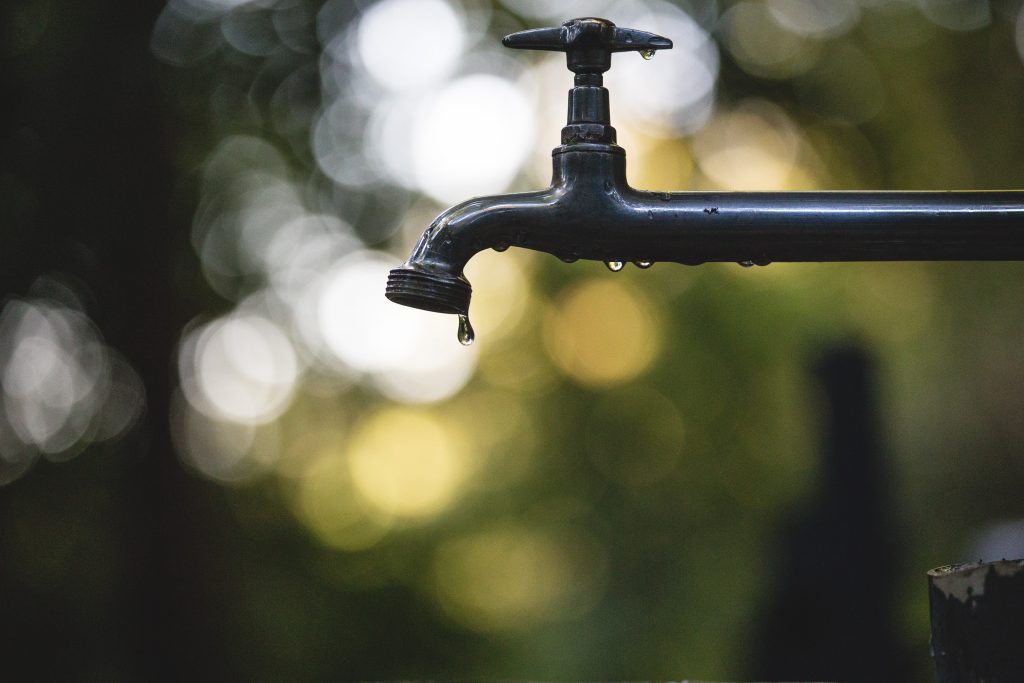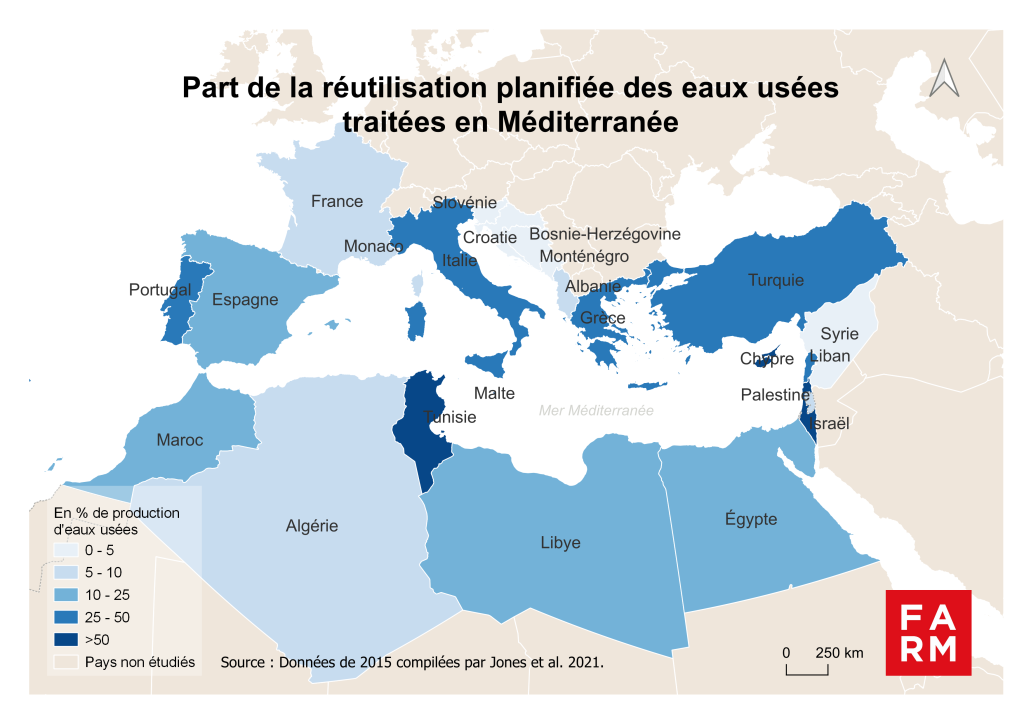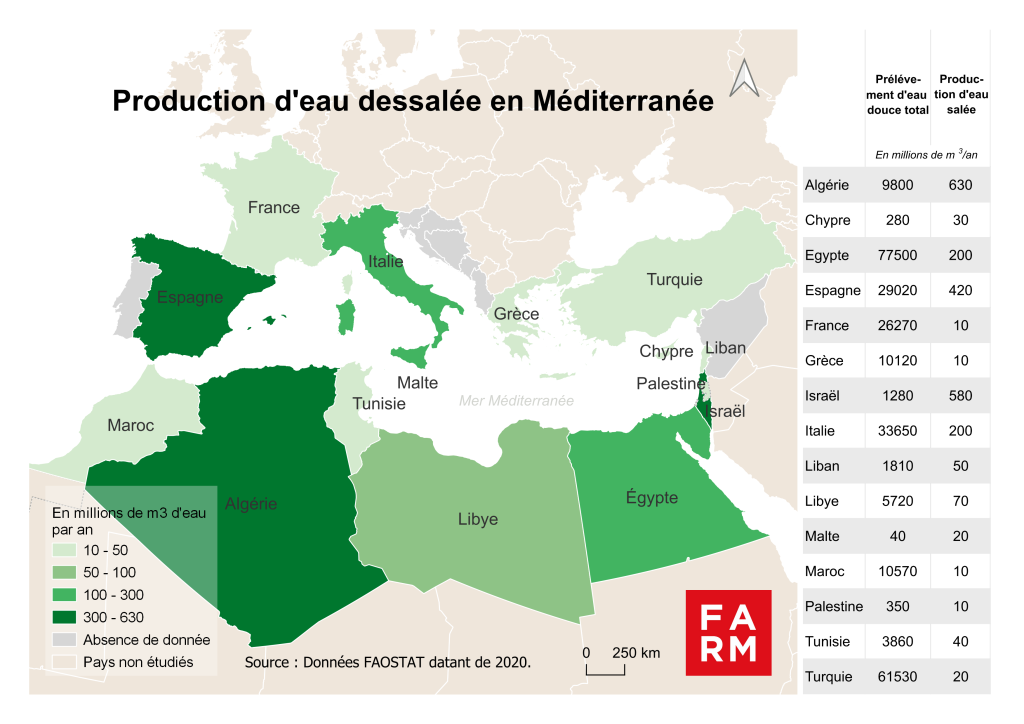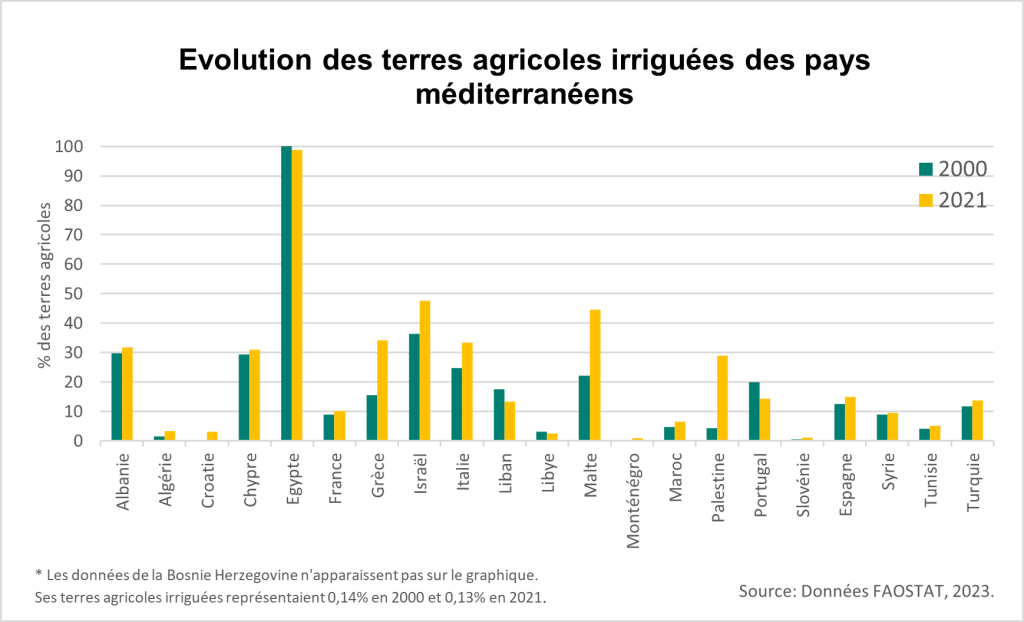Droughts in the Mediterranean: what adaptation levers for agriculture?
THE droughts and heat waves in the Mediterranean are pushing farmers to implement adaptation strategies to reduce their vulnerability and ensure their yields. Several options have emerged in recent years based on water supply and demand management as well as changes in practices. To cope with these droughts, however, there is no single solution but rather a set of levers to be adapted locally. The FARM Foundation offers an analysis of these solutions and the controversies surrounding them.

More resources by mobilizing unconventional waters?
In countries facing severe water stress or even water shortages, techniques have emerged to increase water availability, in particular, via the mobilization of unconventional waters[1]Among them, the desalination of seawater and the reuse of treated wastewater (REUT) have been developing around the Mediterranean over the last two decades.

Wastewater are waters altered by human activity (domestic, municipal, industrial, agricultural). They can be treated and discharged into the natural aquatic environment, or – informally – be directly reused without having been treated. Pierre-Louis Mayaux, water policy researcher at CIRAD and co-author of a special issue of the journal Water Alternatives on unconventional waters also specifies that " the vast majority of reuse is still done on untreated wastewater, particularly in arid and semi-arid contexts ". The term REUT – for reuse of wastewater – therefore refers to a formal use at the outlet of a treatment plant, supervised and planned by the State. In the Mediterranean, Israel and Tunisia are the pioneers of REUT. From the 1960s – 1970s, treatment plants were developed there to use water in agriculture to save citrus production in the Soukra region of Tunisia.[2] or in vegetable and then cotton crops in Israel[3]In the Mediterranean, REUT is being developed to irrigate green spaces and golf courses as well as for urban, industrial and agricultural uses, and even to recharge water tables.[4].
Desalination will allow salty sea water to be treated using thermal or reverse osmosis processes in order to obtain drinking water intended for human consumption, or more rarely, to irrigation. Able to bear the energy costs of such technology, the first countries to develop it were the Gulf oil monarchies and the United States. Desalination in the Mediterranean developed strongly from the 1990s to the 2000s, particularly in Israel, Algeria and Spain, as shown in the map below.

However, these two technologies are not without controversy (cost, energy consumption and environmental impact).
First of all, in terms of cost, on average, in 2016, desalinated water, produced with current technologies, cost four to five times more than treated surface water, while consuming 23 times more energy.[5],[6] REUT for agricultural use is also more expensive because it often requires additional tertiary treatments. Huge public investments are therefore needed to build desalination plants and improve water treatment systems, but also to cover the day-to-day operating and water supply costs. " explains Pierre-Louis Mayaux. Thus, the selling price of water from REUT cannot reflect its real production cost because farmers would not be able to cover it. In the case of Souss in Tunisia that the researcher is studying, the prices paid by farmers only cover 2.% of the operating cost. Similarly, water from desalination is too costly to be used in productions that have low economic water productivity, such as cereals. Therefore, the only products for which desalinated water can be considered are high-end products, most often intended for export, such as berries.[7].
Second, the high energy consumption of desalination plants results in a very significant climate cost. Indeed, they are mainly powered by fossil fuels. Seawater desalination by reverse osmosis – the most widespread process today – emits between 0.4 and 6.7 kg CO2eq/m3 when the REUT emits between 0.1 and 2.4 kg CO2eq/m3[8]Desalination alone could emit 400 million tonnes of CO2 in 2050[9]] The industry is still looking for solutions to this problem by improving processes or using renewable energies.[10] (solar, geothermal, etc.). These only represented 1.% of the energy dedicated to desalination in 2017.
These two techniques also have significant ecological and even social impacts. Desalination, for its part, leads to a significant discharge of brine – water that is highly salty, polluting and sometimes hot – into the sea. This water can cause coastal pollution and affect marine ecosystems.[11]. For their part, the water used for REUT is not a new resource unlike desalination. Treated wastewater is an integral part of the hydrological cycle since it is released into aquatic environments. When it did not go into the treatment process, it benefited ecosystems such as Moroccan and Tunisian palm groves. REUT projects, although they limit health risks through treatment, do not redistribute the treated water to these former informal users but to new users, thus depriving them of an essential resource. Inequalities can then arise in the allocation of the resource.
According to Pierre-Louis Mayaux of CIRAD, these projects are also often presented as substitutes for a dwindling resource like groundwater. However, no means are put in place to ensure that farmers stop using their wells. Instead of being saved, water ends up accumulating, which leads to the issue of water conservation not being addressed.
Faced with these different observations, it seems important to repoliticize the debates around these techniques, by presenting them as alternatives among others, and not as self-evident, at the risk of falling into maladaptation.[12]. Indeed, desalination and REUT technologies will prove indispensable in certain contexts of water shortage, but alternatives may be more suitable in other cases. The researcher cites, for example, the use of rainwater collectors, which have proven their worth in Brazil, with the installation of millions of tanks in the 2000s. It is also possible to direct investments towards less water-intensive agriculture and irrigation techniques, as discussed in the following paragraphs.
Micro-irrigation to consume less water?
Faced with the decline in total precipitation linked to climate change in the Mediterranean, irrigation has been considered in the region as a solution to ensure production. Depending on the countries around the Mediterranean, irrigation is more or less developed, as shown in the graph below. While improving these techniques can be a lever to limit water stress in plants, they still remain subject to a major challenge: the scarcity of resources.

Certain agricultural development programs, such as the Green Morocco Plan (2008-2020)[13], encourage farmers to adopt water-saving irrigation techniques. These farmers are then turning more towards micro-irrigation, such as drip irrigation, rather than surface flow irrigation. The latter, also called gravity irrigation, relies on water distribution via canals under the effect of gravity. Ali Hatimy, agriculture and markets project manager at Nitidæ and co-founder of the popularization site Nechfate explains to us that " In the early 2000s, gravity-fed irrigation was heavily criticized for its inefficiencies. " Flooding plots for a short time would lead to water losses linked to high evaporation. On the other hand, micro-irrigation, such as drip irrigation, consists of bringing water to the base of the plant in a very localized, controlled manner and according to its needs. In theory, drip irrigation displays an irrigation efficiency (EI)[14] of more than 90 % compared to 40 to 60 % for gravity irrigation. Based on these results, the Green Morocco Plan offered subsidies for the purchase of drip equipment to farmers wishing to convert to it.
However, the water savings expected from converting to drip irrigation are not always optimal. They can sometimes even be negative and contribute to the overexploitation of groundwater resources.[15]. At the basin scale, " Gravity irrigation actually allows water to re-infiltrate into the water table and potentially be reused by other farmers, depending on the context, which drip irrigation does not allow. " explains Ali Hatimy. The 90 % efficiency of drip irrigation should also be put into perspective, according to the expert, existing only in a perfect context, with optimal use of the equipment and where the farmer is properly trained in its use, which is not always the case. Indeed, according to him, the latter have a tendency to over-irrigate voluntarily by transposing this habit, coming from gravity irrigation, to drip irrigation. This practice could be optimal for gravity irrigation because it is practiced over a short time, whereas with drip irrigation, which is done continuously, it leads to over-irrigation. Farmers may also have faulty or poorly maintained equipment, which they compensate for by more irrigation[16],[17]] The observed efficiency of drip irrigation would therefore be between 25 and 107 %, depending on practices and crops. Indeed, according to case studies conducted in Morocco by Benouniche et al. (2014), irrigation efficiency depends on farmers' logic. The authors take the example of large farmers who have an EI between 46 and 66 %. These farmers are in an expansion logic, with less than optimal irrigation practices and maintenance, coupled with a certain water comfort, so they practice over-irrigation to ensure yields. For their part, market gardeners have an EI between 65 and 107 %. They maintain the equipment more, improve the system over time, and practice irrigation that experts consider to be water-efficient, since it is relatively more subject to shortages.
Micro-irrigation also faces the Jevons paradox and even the rebound effect. Conversion to drip irrigation, which is supposed to save water, is accompanied by intensification at the farm level and diversification or even reconversion towards higher value-added crops, which are more profitable, but also more water-intensive.[18]The very notion of saving water can also be interpreted very differently depending on the actors and the scales: is it about reducing losses, increasing productivity per m3 of water used or even to reduce abstractions? In the case of the Green Morocco Plan, for example, the introduction of drip irrigation ultimately had agricultural intensification as its primary objective, not water saving. Indeed, no meter accompanied the installation of drip irrigation infrastructure, including subsidized ones. There is therefore no way to ensure a real reduction in water consumption. An effective water policy to regulate the use of resources also remains difficult to envisage due to a lack of resources for basin agencies.[19] or because of the existing influence games at the local level, and this, in most Mediterranean countries.
Ali Hatimy nevertheless insists that drip irrigation has enabled great progress in Morocco, particularly in terms of agricultural intensification, which would not have been possible – to this extent – with the simple use of gravity. Promoting this technology in the Mediterranean, however, must be accompanied by a sobriety component. As the researcher points out, water is currently rarely an adjustment variable for farmers with more or less unlimited access to groundwater. via wells, especially among large farmers. The latter are more constrained by the market. By introducing the imperative of sobriety, agricultural strategies will become more complex, in terms of crop diversity for example.
Species and varieties better adapted to reduce water requirements?
To cope with long-term water and heat stress, some Mediterranean farmers are turning to more adapted species and varieties. They are looking for plants that are more tolerant of heat and drought, for example, thanks to a deep root system, shorter or earlier crop cycles, or the ability to limit transpiration or store water. Farmers and seed breeders can thus introduce species grown in arid climates, such as sorghum, or reintroduce more resistant traditional species.[20], sometimes fallen into disuse. The improvement of cultivated plants can also be an option to transmit one or more traits of interest to a new variety. This selection has existed since the beginning of plant domestication 10,000 years ago and today takes various forms (farmer seeds selected on the farm, seeds selected by seed companies, New Breeding Techniques (NBT), etc.). The FARM Foundation has dedicated a series of articles and interviews to the seed sector in Africa which return to the levers of improvement of the seed heritage of the continent by giving the floor to Million Belay of AFSA, SEMAE And Justin Rakotoarisaona of AFTSA.
If improvement and varietal selection are an interesting lever, " It is sometimes difficult to find a water-saving variety that matches current yields. " warns Ali Hatimy. The researcher points out that, in the Moroccan context, in the absence of stronger management of water demand and a variety with maximum yield, it is unlikely that tomato producers will adopt a variety whose productivity will be 15 % lower.
To introduce and reintroduce new species and varieties, it is essential to develop a reflection at the level of sectors and markets in order to enable the valorization of these new productions and to guarantee yields and incomes for producers. The sustainability of these sectors requires the existence of distribution and processing channels. It is also necessary to ensure the emergence of a demand for these products, involving both nutritional and taste interest in the product and reasonable prices, depending on the target. In this context, public support, such as subsidies, can prove relevant to accompany the sector. Food policies are also necessary to ensure the promotion of these products. As Serge Zaka, agro-climatologist, emphasizes: " We need to move production and consumption forward in parallel. If we don't change anything in consumption, no one will buy what farmers produce. It's the government's role to invest, and it's also the consumers' role to support this transition. " Added to this is the role of the agri-food industries in the development and processing of these products. It is therefore essential to correlate agricultural policies and food policies.
Ultimately, the three experts came to the same conclusion: Mediterranean agriculture must undergo profound transformation in the face of dwindling water resources and heat stress. Adaptation strategies must both encourage water efficiency and ensure agricultural production. This will require mobilizing several levers depending on the context and reconciling short- and long-term thinking. In addition, other complementary adaptation levers exist in agriculture, such as soil cover and crop diversity.[21] or agroforestry. Adapting agriculture today requires the mobilization of all stakeholders, from farmers to consumers and public authorities, while selecting, prioritizing, and locally adapting the range of existing levers. This will require a broad political debate that “must enable the different choices to be highlighted, discussed collectively and the options to be implemented to be deliberated upon” concludes Pierre-Louis Mayaux.
[1] This concept can also include water from rainwater harvesting, fog, iceberg transport, etc. (Williams et al. 2023)
[2] Hamdane. 2021. Development and management of irrigation in Tunisia.
[3] Juanico. 2008. Israel as a case study – Wasterwater Reclamation and Reuse.
[4] Condom et al. 2012. Reuse of treated wastewater in the Mediterranean: feedback and assistance in developing projects.
[5] World Bank. 2016. High and Dry: Climate Change, Water, and the Economy.
[6] De Waal et al. 2023. The Economics of Water Scarcity in the MENA: Institutional Solutions.
[7] De Waal et al. 2023. The Economics of Water Scarcity in the MENA: Institutional Solutions.
[8] Carnejo et al. 2014. “Carbon footprint of water reuse and desalination: review of emissions and tools”.
[9] Eyl-Mazzega and Cassignol. 2022. “Geopolitics of seawater desalination”. Study from Ifri.
[10] Bundschuh et al. 2021. “State-of-the-art of renewable energy sources used in water desalination”.
[11] Jones et al. 2019. “The state of desalination and brine production: A global outlook”.
[12] Pierre-Louis Mayaux defines maladaptation here as "any measure that reduces a community's capacity to adapt in the future." This notion is in debate.
[13] Nechfate offers an analysis of the water saving policies in Morocco as part of the Green Morocco Plan.
[14] Irrigation efficiency (EI) is the ratio between plant needs and irrigation dose. The lower the EI, the greater the water losses.Benouniche et al. 2014).
[15] FAO. 2017. Does improved irrigation technology save water? A review of the evidence.
[16] Gontard. 2020. « The search for maximum water efficiency, an objective that should not be disconnected from an integrated vision of the production system" .
[17] Benouniche, Kuper and Hammani. 2014. « Leading the drip-feed to water savings: realistic ambition or chasing a pipe dream? »
[18] Molle and Tanouti. 2017. « Micro-irrigation and water resources in Morocco: a costly misunderstanding" .
[19] World Bank. 2022. Climate and Development Report.
[20] Bonjean, Monneveux and Zaharieva. 2019. Wheat from Saharan oases: genetic resources of prime importance for tackling climate change.
[21] Thuillet and Vigouroux. 2021. Biodiversity and adaptation of crops to climate change in the Global South.
